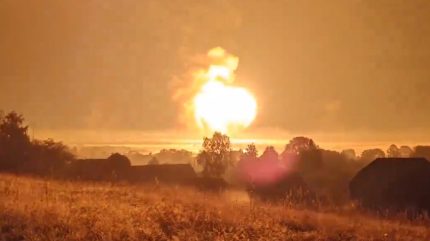
Ukraine appears to have shifted its modus operandi for long-range strikes into Russia away from the targe sites of critical national infrastructure, such as oil and gas storage sites, to ammunition and supply depots, far behind the front lines.
In particular, a series of strikes carried out in September point towards a near-term shift in operations, with the deliberate targetting of Russian ammunition depots in Tikhoretsk and Toropets around mid-to-late September as prime examples of this shift.

Discover B2B Marketing That Performs
Combine business intelligence and editorial excellence to reach engaged professionals across 36 leading media platforms.
The strike on Toropets in particular resulted in one of the largest explosions on the Eurasian continent in recent times, with a force measured at 2.7 on the Richter scale.
It is possible that the strikes were carried out by Ukraine using its new Palianytsia munition, which aesthetically appears to be a hybrid of cruise missile and long-range drone. The strikes on Tikhoretsk and Toropets were around 300km and 500km inside Russian territory respectively, with the latter site alone struck twice in September.
Monitoring the strikes, Western officials point to a shift in Ukrainian strategy, although it is not known whether this represents a short-term change, or points to a longer-term decision. It is thought that up to 100,000 tonnes of ammunition was destroyed.
The development of the Palianytsia munition by Ukraine has gone some way to negating restrictions being placed on it by its Western backers of the ATACMS and Storm Shadow missiles, provided by the US and UK respectively. Both countries currently prohibit Ukraine using such weapons to strike targets inside Russia.

US Tariffs are shifting - will you react or anticipate?
Don’t let policy changes catch you off guard. Stay proactive with real-time data and expert analysis.
By GlobalDataRussia maintains quantitative artillery edge
Artillery has been, along with the advent of cheap loitering munitions, one of the key military capabilities to have emerged from the lessons being learned in the Ukraine-Russia war more than two-and-a-half years since the outbreak of large-scale combat operations.
To this end, the ability to maintain a daily rate of fire of artillery against enemy frontlines serves to degrade military capability and have become a prerequisite for softening up positions when defence turns to attack. In this respect, the combat being seen in Ukraine is not dissimilar to the major wars of the 20th Century, where artillery carried significant influence.
In targetting Russian ammunition stores, Ukraine is likely looking to provide some respite for its frontline forces that are on the backfoot across many areas of the frontline.
Russia requires around six million artillery rounds per year to maintain its current rate of firings, with around half of what is needed currently being provided by North Korea and the remainder coming from Moscow’s own stocks.
It is thought that Russia advantage of Ukraine in terms of daily ammunition expenditure is around 9:1 ratio, with the reduction of this disparity of paramount importance to Kyiv.
War update: Russia grinds west
Recent days and weeks in Ukraine have continued to see Russia push gradually westwards, capturing the town of Vuledar in early October after months of bloody urban combat.
Russian casualty rates are currently thoughts to be at around 1,200 per day across the eastern and southeastern fronts. Ukraine’s Ministry of Defence claims that more than 660,000 Russian military personnel have been killed or wounded since February 2022.
Although exact casualty figures are difficult to determine due to inflated claims by both Ukraine and Russia, it was reported by Army Technology in June that around 500,000 military personnel across both sides had been killed or wounded in the war.
Extrapolating assessed daily casualty figures from the start of H2 2024, it is possible that combined figures now run to approximately 600,000, and potentially higher.
Meanwhile, following a concentration of forces, Russia has begun its counterattack against Ukrainian forces occupying the Kursk bulge, which was unexpectedly seized in August this year.



